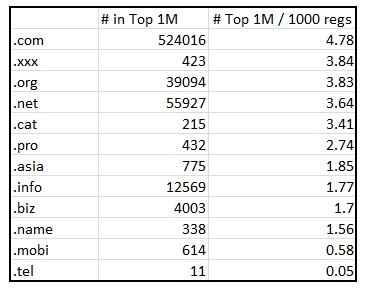In which areas are most popular sites?
There are different methods for evaluating domain zones. The main criterion (primarily for registrars) is the total number of registered second-level domains. High figures suggest that the company has chosen the right commercial strategy, and the domain zone will bring it greater profits.
However, it is impossible to unambiguously judge from these numbers the “state of health” of the domain zone. If there are a lot of second-level domains in it, but there are few working sites on them or they are scarcely visited, then a collapse may soon await it.
For most of the domain zones, the criterion of health and stability can be served by the number and percentage of popular sites hosted in it. In the table below, the second column shows the total number of second-level domains belonging to the million most popular sites on the Internet (according to Alexa data). In the third column - the average number of sites in the top million of 1000 registered names.
')

These indicators largely reflect the opinion of specialists and ordinary users about the reputation and prospects of domain zones. There are not many registered sites in the adult domain. XXX, but its popularity and commercial success have caused a real sensation. On the contrary, a much more numerous zone .info enjoys a bad reputation because of the high level of cybersquatting, spamming and other malicious actions from this zone.
But it should be noted that such a method is not very suitable for evaluating some highly specialized domain zones with special requirements for content sites, such as .mobi and .tel.
Among the national domain zones, the highest rates are in the domains of Greece (.gr), Japan (.jp) and Russia (.ru). But these data cannot be considered completely reliable, since for a number of national zones it is impossible to find accurate data on the number of second-level domains.
However, it is impossible to unambiguously judge from these numbers the “state of health” of the domain zone. If there are a lot of second-level domains in it, but there are few working sites on them or they are scarcely visited, then a collapse may soon await it.
For most of the domain zones, the criterion of health and stability can be served by the number and percentage of popular sites hosted in it. In the table below, the second column shows the total number of second-level domains belonging to the million most popular sites on the Internet (according to Alexa data). In the third column - the average number of sites in the top million of 1000 registered names.
')

These indicators largely reflect the opinion of specialists and ordinary users about the reputation and prospects of domain zones. There are not many registered sites in the adult domain. XXX, but its popularity and commercial success have caused a real sensation. On the contrary, a much more numerous zone .info enjoys a bad reputation because of the high level of cybersquatting, spamming and other malicious actions from this zone.
But it should be noted that such a method is not very suitable for evaluating some highly specialized domain zones with special requirements for content sites, such as .mobi and .tel.
Among the national domain zones, the highest rates are in the domains of Greece (.gr), Japan (.jp) and Russia (.ru). But these data cannot be considered completely reliable, since for a number of national zones it is impossible to find accurate data on the number of second-level domains.
Source: https://habr.com/ru/post/186142/
All Articles